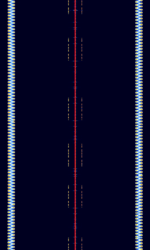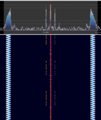VHF Omnidirectional Range (VOR)
A type of radio navigation system used by aircraft. It is distinctive in that the center frequency is flanked by two FMFrequency Modulation waves. The center carrier may have subcarriers of AMAmplitude Modulation voice, morse code identifier, or both.
Frequencies[edit]
VORs are assigned radio channels between 108.0 MHzMegaHertz (MHz) 10^6 Hz and 117.95 MHzMegaHertz (MHz) 10^6 Hz (with 50 kHzKiloHertz (kHz) 10^3 Hz spacing); this is in the Very High Frequency (VHFVery High Frequency (30-300 MHz)) range. The first 4 MHzMegaHertz (MHz) 10^6 Hz is shared with the Instrument landing system (ILS) band. To leave channels for ILS, in the range 108.0 to 111.95 MHzMegaHertz (MHz) 10^6 Hz, the 100 kHzKiloHertz (kHz) 10^3 Hz digit is always even, so 108.00, 108.05, 108.20, 108.25, and so on are VOR frequencies but 108.10, 108.15, 108.30, 108.35 and so on, are reserved for ILS in the US.






